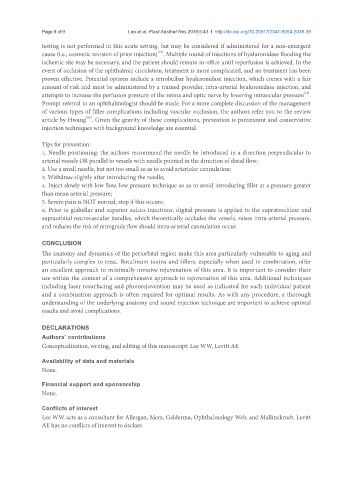Page 322 - Read Online
P. 322
Page 8 of 9 Lee et al. Plast Aesthet Res 2018;5:43 I http://dx.doi.org/10.20517/2347-9264.2018.39
testing is not performed in this acute setting, but may be considered if administered for a non-emergent
[19]
cause (i.e., cosmetic revision of prior injection) . Multiple round of injections of hyaluronidase flooding the
ischemic site may be necessary, and the patient should remain in-office until reperfusion is achieved. In the
event of occlusion of the ophthalmic circulation, treatment is more complicated, and no treatment has been
proven effective. Potential options include a retrobulbar hyaluronidase injection, which comes with a fair
amount of risk and must be administered by a trained provider, intra-arterial hyaluronidase injection, and
[16]
attempts to increase the perfusion pressure of the retina and optic nerve by lowering intraocular pressure .
Prompt referral to an ophthalmologist should be made. For a more complete discussion of the management
of various types of filler complications including vascular occlusion, the authors refer you to the review
[16]
article by Hwang . Given the gravity of these complications, prevention is paramount and conservative
injection techniques with background knowledge are essential.
Tips for prevention:
1. Needle positioning: the authors recommend the needle be introduced in a direction perpendicular to
arterial vessels OR parallel to vessels with needle pointed in the direction of distal flow;
2. Use a small needle, but not too small so as to avoid arteriolar cannulation;
3. Withdraw slightly after introducing the needle;
4. Inject slowly with low flow, low pressure technique so as to avoid introducing filler at a pressure greater
than mean arterial pressure;
5. Severe pain is NOT normal; stop if this occurs;
6. Prior to glabellar and superior sulcus injections, digital pressure is applied to the supratrochlear and
supraorbital neurovascular bundles, which theoretically occludes the vessels, raises intra-arterial pressure,
and reduces the risk of retrograde flow should intra-arterial cannulation occur.
CONCLUSION
The anatomy and dynamics of the periorbital region make this area particularly vulnerable to aging and
particularly complex to treat. Botulinum toxins and fillers, especially when used in combination, offer
an excellent approach to minimally invasive rejuvenation of this area. It is important to consider their
use within the context of a comprehensive approach to rejuvenation of this area. Additional techniques
including laser resurfacing and photorejuvention may be used as indicated for each individual patient
and a combination approach is often required for optimal results. As with any procedure, a thorough
understanding of the underlying anatomy and sound injection technique are important to achieve optimal
results and avoid complications.
DECLARATIONS
Authors’ contributions
Conceptualization, writing, and editing of this manuscript: Lee WW, Levitt AE
Availability of data and materials
None.
Financial support and sponsorship
None.
Conflicts of interest
Lee WW acts as a consultant for Allergan, Merz, Galderma, Ophthalmology Web, and Mallinckrodt. Levitt
AE has no conflicts of interest to declare.

